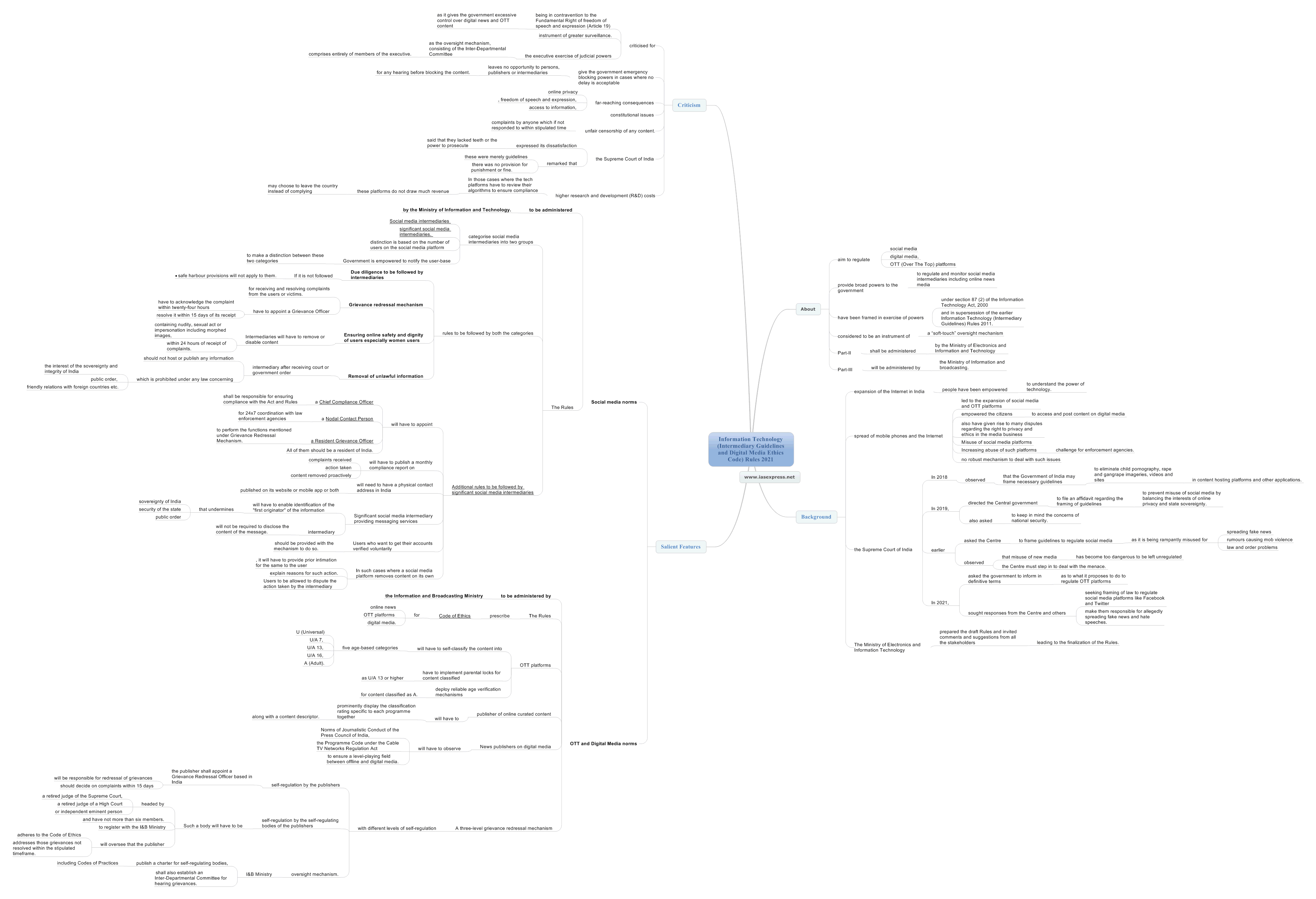Information Technology (Intermediary Guidelines and Digital Media Ethics Code) Rules 2021 (New IT Rules)

From Current Affairs Notes for UPSC » Editorials & In-depths » This topic
IAS EXPRESS Vs UPSC Prelims 2024: 85+ questions reflected
Recently, the Government of India notified the new Information Technology (Intermediary Guidelines and Digital Media Ethics Code) Rules 2021 in the wake of growing concern around transparency, accountability and rights of users related to digital media. The rules aim to regulate social media, digital media, and OTT (Over The Top) platforms. The Rules provide broad powers to the government to regulate and monitor social media intermediaries including online news media. The Rules have been framed in exercise of powers under section 87 (2) of the Information Technology Act, 2000 and in supersession of the earlier Information Technology (Intermediary Guidelines) Rules 2011. The Rules are considered to be an instrument of a “soft-touch” oversight mechanism. The Part-II of these Rules shall be administered by the Ministry of Electronics and Information and Technology and Part-III will be administered by the Ministry of Information and broadcasting.
Background
- With the expansion of the Internet in India, people have been empowered to understand the power of technology. The spread of mobile phones and the Internet has also led to the expansion of social media and OTT platforms in India.
- These developments have not only empowered the citizens to access and post content on digital media but also have given rise to many disputes regarding the right to privacy and ethics in the media business. Misuse of social media platforms by antisocial elements and business entities for their vested interests has been a rampant issue. Increasing abuse of such platforms has been a challenge for enforcement agencies.
- It was noticed that there was no robust mechanism to deal with such issues. All the stakeholders needed a mechanism to redress their grievances within a stipulated time.
- In 2018, the Supreme Court of India had observed that the Government of India may frame necessary guidelines to eliminate child pornography, rape and gangrape imageries, videos and sites in content hosting platforms and other applications.
- In 2019, the Supreme Court of India directed the Central government to file an affidavit regarding the framing of guidelines to prevent misuse of social media by balancing the interests of online privacy and state sovereignty. The Bench also asked to keep in mind the concerns of national security.
- The Supreme Court of India had earlier asked the Centre to frame guidelines to regulate social media as it is being rampantly misused for spreading fake news and rumours causing mob violence and law and order problems. The Supreme Court observed that misuse of new media has become too dangerous to be left unregulated and the Centre must step in to deal with the menace.
- In 2021, the Supreme Court of India had asked the government to inform in definitive terms as to what it proposes to do to regulate OTT platforms after a plea was filed for regulating such platforms. In the same year, the apex court sought responses from the Centre and others on a plea seeking framing of law to regulate social media platforms like Facebook and Twitter and make them responsible for allegedly spreading fake news and hate speeches.
- The Ministry of Electronics and Information Technology prepared the draft Rules and invited comments and suggestions from all the stakeholders leading to the finalization of the Rules.
Salient Features
- Social media norms to be administered by the Ministry of Information and Technology.
- The Rules categorise social media intermediaries into two groups:- Social media intermediaries and significant social media intermediaries. The distinction is based on the number of users on the social media platform. The Government is empowered to notify the user-base to make a distinction between these two categories.
- The rules to be followed by both the categories:-
- Due diligence to be followed by intermediaries – The intermediaries including the social media intermediaries have to follow due diligence. If it is not followed, safe harbour provisions will not apply to them.
- Grievance redressal mechanism – The intermediaries have to establish a grievance redressal mechanism for receiving and resolving complaints from the users or victims. They have to appoint a Grievance Officer to deal with such complaints and the officer will have to acknowledge the complaint within twenty-four hours and resolve it within 15 days of its receipt.
- Ensuring online safety and dignity of users especially women users – Intermediaries will have to remove or disable content containing nudity, sexual act or impersonation including morphed images, within 24 hours of receipt of complaints.
- Removal of unlawful information – An intermediary after receiving court or government order, should not host or publish any information which is prohibited under any law concerning the interest of the sovereignty and integrity of India, public order, friendly relations with foreign countries etc.
- Additional rules to be followed by significant social media intermediaries:-
- Significant social media intermediaries will have to appoint a Chief Compliance Officer(shall be responsible for ensuring compliance with the Act and Rules), a Nodal Contact Person for 24×7 coordination with law enforcement agencies and a Resident Grievance Officer to perform the functions mentioned under Grievance Redressal Mechanism. All of them should be a resident of India.
- Significant social media intermediaries will have to publish a monthly compliance report on complaints received, action taken, and content removed proactively.
- Significant social media intermediary will need to have a physical contact address in India published on its website or mobile app or both.
- Significant social media intermediary providing messaging services will have to enable identification of the “first originator” of the information that undermines the sovereignty of India, security of the state, or public order. The intermediary will not be required to disclose the content of the message.
- Users who want to get their accounts verified voluntarily should be provided with the mechanism to do so.
- In such cases where a social media platform removes content on its own, it will have to provide prior intimation for the same to the user and explain reasons for such action. Users to be allowed to dispute the action taken by the intermediary.
- OTT and Digital Media norms to be administered by the Information and Broadcasting Ministry
- The Rules prescribe a Code of Ethics for online news, OTT platforms and digital media.
- The OTT platforms will have to self-classify the content into five age-based categories – U (Universal), U/A 7, U/A 13, U/A 16, and A (Adult).
- The platforms have to implement parental locks for content classified as U/A 13 or higher and deploy reliable age verification mechanisms for content classified as A.
- The publisher of online curated content will have to prominently display the classification rating specific to each programme together along with a content descriptor. This will enable users to make an informed decision before watching the programme.
- News publishers on digital media will have to observe Norms of Journalistic Conduct of the Press Council of India, and the Programme Code under the Cable TV Networks Regulation Act to ensure a level-playing field between offline and digital media.
- A three-level grievance redressal mechanism has been established with different levels of self-regulation under the rules. These are self-regulation by the publishers; self-regulation by the self-regulating bodies of the publishers; and oversight mechanism.
- Under the rules of self-regulation by the publisher, the publisher shall appoint a Grievance Redressal Officer based in India who will be responsible for redressal of grievances and should decide on complaints within 15 days.
- Under the rules of the self-regulatory body, there may be one or more self-regulatory bodies of publishers. Such a body will have to be headed by a retired judge of the Supreme Court, a High Court or independent eminent person and have not more than six members. This body, which will have to register with the I&B Ministry, will oversee that the publisher adheres to the Code of Ethics and addresses those grievances not resolved within the stipulated timeframe.
- I&B Ministry will formulate an oversight mechanism and publish a charter for self-regulating bodies, including Codes of Practices. It shall also establish an Inter-Departmental Committee for hearing grievances.
Criticism
- The Rules are being criticised for being in contravention to the Fundamental Right of freedom of speech and expression (Article 19) as it gives the government excessive control over digital news and OTT content. These Rules are believed to be an instrument of greater surveillance.
- Furthermore, the Rules are being criticised for the executive exercise of judicial powers as the oversight mechanism, consisting of the Inter-Departmental Committee comprises entirely of members of the executive.
- The Rules give the government emergency blocking powers in cases where no delay is acceptable. This leaves no opportunity to persons, publishers or intermediaries for any hearing before blocking the content.
- The Rules have been further criticised for having far-reaching consequences on online privacy, freedom of speech and expression, and access to information, in addition to the constitutional issues that the Rules suffer from.
- While the government is encouraging self-censorship, it will be difficult for any publisher to comply with all the rules. This may invite complaints by anyone which if not responded to within stipulated time may lead to restrictions on the online content. This will lead to unfair censorship of any content.
- Hearing a plea, the Supreme Court of India expressed its dissatisfaction with the new IT Rules and said that they lacked teeth or the power to prosecute. The court remarked that these were merely guidelines and there was no provision for punishment or fine.
- In those cases where the tech platforms have to review their algorithms to ensure compliance, this could lead to higher research and development (R&D) costs. It will be against India’s interests as these platforms do not draw much revenue from India and thus may choose to leave the country instead of complying.
The road ahead
In the era of rising digital media and tech platforms, it was a necessary proposition to introduce some guidelines to monitor these areas. The new IT Rules are a step forward in this direction yet the government has to do a little more by holding consultations with all the stakeholders keeping in mind their rights and ensuring justice to all of them.
Practise Question
- What are the new guidelines issued under IT Rules, 2021 and what are the limitations of the new rules?
If you like this post, please share your feedback in the comments section below so that we will upload more posts like this.


